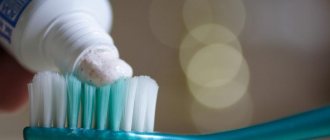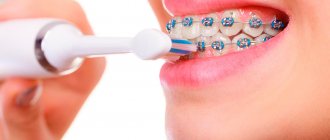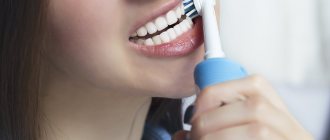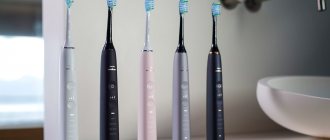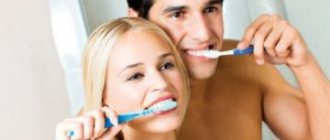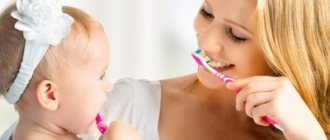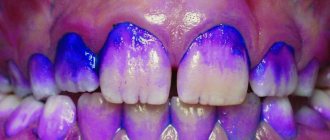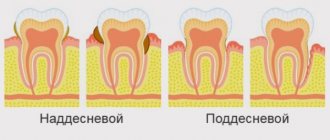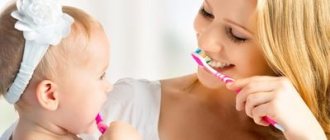During orthodontic treatment, patients experience difficulties with oral hygiene. This happens because the braces themselves and the arch that connects them prevent a regular toothbrush from cleaning plaque and food debris from the dental spaces. Moreover, the foreign complex structure itself becomes an additional source of infection, collecting the same food debris on the surface.
This problem can have serious consequences, since the dentist’s ability to prevent and treat caries while the patient is wearing braces is also significantly limited. Taking this fact into account, it is worthwhile to monitor oral hygiene as carefully as possible during the active phase of bite correction. You need to purchase everything for caring for braces from an online store or pharmacy. The dentist will definitely give you a list of necessary devices after installing the orthodontic structure.
Can I have my teeth with braces cleaned at Dial-Dent if I am undergoing treatment in another clinic?
We accept all patients, no matter whether they undergo orthodontic treatment at Dial-Dent, in another clinic, or with a private specialist. Teeth should be clean and healthy! It's the most important!
There are advantages for patients of the Dial-Dent orthodontic department.
- You can combine a visit to the orthodontist (scheduled visit) and professional dental hygiene without wasting time visiting different clinics.
- If there is severe plaque buildup, the orthodontist may remove the wire from the bracket system before cleaning. After dental hygiene, the arch is installed in place. Since cleaning does not last long, orthodontic treatment is not interrupted. Removing the wires allows you to better clean all elements of the braces system, as well as the teeth around the braces and along the gums.
In any case, the teeth will be cleaned to the highest possible quality, just the time spent on brushing will differ.
Ultrasound and whitening
There are alternative methods of cleaning the oral cavity, for example, using ultrasound. Unfortunately, this technology has contraindications. Dental treatment is rarely carried out under local anesthesia, since the patient does not experience any unpleasant sensations during the process.
Thanks to the smallest vibrations, plaque leaves the enamel in a matter of seconds, resulting in it remaining smooth and shiny for a long time. However, ultrasound can only be applied to gum pockets and interdental spaces; the areas around the clasps cannot be treated. This is argued by the fact that the glue on which they are fixed may soften and cease to hold the structure properly.
You cannot whiten your teeth during treatment with braces due to the aggressive effects of the whitening solution used. It can change the shade of the enamel, but it cannot penetrate under the base of the staple, so the color will be uneven. Whitening should be postponed until the braces are removed. Careful care and regular cleaning of teeth during orthodontic treatment is the key to obtaining the desired result without complications and in the shortest possible time.
previous post
What's the difference between sapphire and ceramic braces?
next entry
Is it necessary to undergo professional hygiene if I brush my teeth well at home?
Before starting orthodontic treatment, all Dial-Dent patients undergo training in cleaning teeth with braces at home and receive a gift set of teeth care products with braces. Even under these conditions, professional teeth cleaning is mandatory, since braces on the teeth create many places that are difficult to reach for cleaning on your own. Plaque mainly accumulates around braces, under archwires, along the gum line, and on the inner surface of teeth. In places where plaque remains for a long time, tartar forms, which cannot be cleaned off on your own.
If you brush your teeth well on your own, your hygienist will schedule another cleaning at a later date.
Before brushing, a plaque indicator is used so that the patient can more clearly see problem areas that need to be given more attention when brushing teeth with braces.
An example of professional teeth cleaning performed by a Dial-Dent hygienist, with the removal of orthodontic arches before cleaning:
An example of professional teeth cleaning performed by a Dial-Dent hygienist, without removing orthodontic arches:
An example of professional teeth cleaning performed by Dial-Dent hygienist Elena Smirnova, without removing orthodontic arches:
Irrigator
An irrigator is an excellent additional hygiene product that effectively cleans teeth, spaces between teeth and gums with a powerful pressure of a thin stream of water. When cleaning with an irrigator, the gums are massaged, which ensures good blood circulation and the prevention of bleeding and gum disease. For orthodontic cleaning you will need a special attachment, but you can continue to use the irrigator with a standard attachment even after the end of orthodontic treatment.
An irrigator is not a replacement for a toothbrush!
What is included in cleaning teeth with braces?
Professional dental cleanings with braces include soft plaque removal using the Air Flow method, in which plaque is washed away with a mixture of cleaning powder and water. Hard plaque and tartar are removed using ultrasound or hand instruments. The enamel is strengthened with special preparations containing fluorine or active compounds of calcium and phosphorus.
In the photo: Dial-Dent hygienist Elena Smirnova performs professional teeth cleaning.
Choosing a toothpaste
The modern variety of toothpastes is great, and their advantages are varied, so it is impossible to determine the best one. In addition, the need for one or another effect of using toothpaste is very individual. There are toothpastes aimed at reducing tooth sensitivity, preventing gum disease, “strengthening” enamel, whitening, and so on.
It’s not so important what you brush your teeth with, the most important thing is to do it correctly.
The choice of toothpaste is yours, or you can consult with your orthodontist and hygienist. The doctor may also recommend a special gel for remineralizing tooth enamel.
It is not necessary to use a lot of paste; usually it is enough to squeeze out a pea-sized amount of paste onto the brush.
How much does professional teeth cleaning cost?
The cost of professional teeth cleaning ranges from 3,900 rubles (Air Flow cleaning only) to 6,900 (comprehensive hygienic cleaning with a large amount of tartar). If tartar is on several teeth, then tartar removal is calculated according to the number of teeth - 280 rubles when removing tartar with ultrasound, or 390 rubles when using hand instruments. The cost of strengthening enamel, for example, with Tuss Mousse cream is 750 rubles.
Before the start of cleaning at the Family Dental Hygienist, the hygienist conducts an examination, on the basis of which he prepares a medical estimate, which indicates what manipulations will be performed and their cost. That is, Dial-Dent patients know the final cost before the procedure begins. If the patient agrees with this estimate, the hygienist begins cleaning the teeth.
What diet should you follow?
There are three main rules that must be followed after installing braces:
- avoidance of excessively hard and “sticky” foods – nuts, seeds, toffees, chewing gums,
- hard fruits and vegetables, meat must be cut into small pieces, chewing with side teeth,
- food and drinks should be warm, but not hot - this can lead to the records coming off.
Your diet should remain unchanged, with the exception of the three points listed. Do not overuse liquid and soft foods - your teeth must receive stress for normal functioning. You can minimize the consumption of viscous foods (chocolate, waffles, chips) - but not because they are prohibited, but because they accumulate on braces and under the archwire. They will simply be very difficult to remove.
What foods are not recommended to be consumed while wearing braces?
Excluding certain foods from your diet will help maintain the health of your teeth and oral cavity when wearing braces. These include viscous, sticky, hard foods and those that provoke enamel hypersensitivity. For example, nuts, candies, crackers, crackers, toffees, marmalade, chewing gum, corn flakes.
Interesting questions
Can I use a regular brush and paste??
A simple brush does not clean your teeth as well as a special one. The accumulation of bacteria in tooth crevices and fastening structures leads to the formation of caries, demineralization of tissue and inflammatory processes in the gums. The paste should also contain fluoride and calcium to maintain dental tissue in good condition.
Can I use an electric brush?
You can, but you need to choose a brush with soft bristles and a narrow head. Its operation should be reciprocating for better cleaning. The attachments need to be changed frequently, every 2-3 weeks, because braces will quickly damage them.
It is necessary to follow all the rules for caring for braces, then, after their removal, you will be pleased not only with straight teeth, but also with white and healthy teeth.
Why do my teeth hurt after installing and activating braces?
In the first days after installation, and subsequently after activation of braces, aching sensations of varying degrees of intensity are possible - the stronger the defect, the greater the pain. When fixing ligature systems, the pressure is greater, so the teeth will hurt more. Soreness in general is a completely normal reaction, since braces from the first minutes after fixation already have an impact on the teeth and change their position.
If the pain is severe, then in the first days after installation or activation of the system, you can take painkillers. But no more than 2-3 days. If discomfort persists, contact your orthodontist for system correction.
What to do if your braces chafe?
For inflammation of the mucous membranes, you can use special gels and ointments that have an antiseptic and soothing effect - for example, Metrogyl Denta, Vinilin.
To prevent inflammation, it is also recommended to use orthodontic wax. The purpose of its use is to isolate and protect soft mucous membranes from solid elements of the system. Apply to sharp protruding parts and replace as they fall off. It is recommended to remove the wax while eating.
Silicone strips for braces, like wax, are used to protect soft mucous membranes. Silicone is presented in the form of strips that can be used to cover one bracket or the entire row. Unlike wax, it does not crumble and is used repeatedly.
What to do if the bracket comes off?
This happens quite rarely. And, as a rule, with budget models that are initially poorly fixed, or after some time after using the system. In such a situation, you need to make an appointment with the orthodontist as quickly as possible, or even come without an appointment during his working hours: gluing the plate will only take a few minutes. Metal braces can be re-glued at least 2-3 times. Ceramic or sapphire - also 1-2 times, but you need to look at their general condition.
It is unlikely that the bracket will be swallowed, since even if it comes off the surface, it will still be fixed to the arch with the help of ligatures or locking fastenings. If the plate does fall off, do not throw it away, but be sure to take it with you to your doctor’s appointment.
How to eat immediately after getting braces
In the first 1-2 weeks after installing braces (as well as after their activation), especially with a significant defect and the choice of ligature structures (they put more pressure on the teeth than self-ligating ones), you will experience pain. The degree of intensity is completely different and depends on many factors, including your sensitivity. Therefore, if at first you find it painful and unpleasant to eat your usual food, change it to a more liquid one - give preference to soups, dairy products, yoghurts, or puree the main dishes. This will reduce the load on the teeth and reduce painful manifestations.
